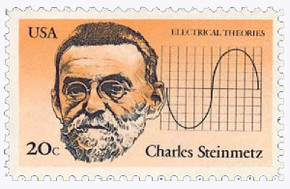
U.S. #2057
1983 20¢ Nikola Tesla
American Inventors
- From a block of 4 stamps issued to honor some of America's top inventors
- Features a portrait and depiction of his invention
Stamp Category: Commemorative
Set: American Inventors
Value: 20¢, first-class rate
First Day of Issue: September 21, 1983
First Day City: Washington, DC
Quantity Issued: 48,263,750
Printed by: Bureau of Engraving and Printing
Printing Method: Lithographed and engraved
Format: Panes of 50 in sheets of 200
Perforations: 11
Why the stamp was issued: To honor one of America's top inventors.
About the stamp design: Designed by Dennis Lyall, the Nikola Tesla stamp pictures the inventor beside his induction motor.
First Day City: The designs for the block of four American Inventors stamps were unveiled three months earlier at a banquet marking the 10th anniversary of the Institute of Electrical and Electronic Engineers. Each of the four inventors had a connection to the institute or one of its two predecessors. The First Day ceremony for the stamps was held at the US Patent and Trademark Office in Arlington, Virginia.
Unusual fact about this stamp: Error stamps exist with the black intaglio missing or dramatically shifted.
About the American Inventors Set: Dennis Lyall designed the block of four American Inventors stamps. As each man had lived since the advent of the camera, he was able to create his stamp portraits from photographs. He also included text describing the invention or discovery they were best known for as well as a depiction of it.
Other stamps in the set picture:
Charles Steinmetz – Electrical Theories – This is the only stamp in the set that doesn’t picture a physical invention. Instead, it pictures a graph representing the square root of minus one.
Edwin Armstrong alongside his frequency modulator;
Philo T. Farnsworth with his first television camera.
History the stamp represents: Nikola Tesla was born on July 10, 1856, in Smiljan, Austrian Empire (present-day Croatia).
The fourth of five children, Tesla discovered as he attended school that he had an eidetic memory – meaning he was able to retain more information and for longer than his fellow students. This sometimes got young Tesla in trouble as his teachers thought him to be cheating.
In 1875, Tesla attended Austrian Polytechnic, a higher-education school in Graz, Austria. Tesla did well in his first year, but later became addicted to gambling and his success faltered. He left the school in 1878. In 1880, Tesla went to several lectures at Charles-Ferdinand University in Prague – he had been too late to formally enroll in the college.
After leaving Prague, Tesla worked at a telegraph company in Budapest before moving to France in 1882 where he worked for the Continental Edison Company. In June 1884, he immigrated to the United States, thanks to a letter Edison received from respected inventor Charles Batchelor. Batchelor wrote, “I know two great men; one is you (Edison) and the other is this young man.” Edison hired Tesla to work for him in New York City. The two worked well together for about a year, but broke ties when Edison refused to pay Tesla a promised amount after he improved several of Edison’s motors and generators.
Tesla then partnered with two businessmen to create Tesla Electric Light and Manufacturing. He filed several patents, all of which he gave to the company. However, his partners then decided they wanted to focus on just supplying electricity. They established a new company, leaving Tesla with nothing. To pay the bills, he reportedly worked as a ditch digger for $2 a day, though he was distraught that his talent was going to waste.
Then in 1887, Tesla met two investors who gave him the funding to create the Tesla Electric Company in Manhattan. While working there, he developed the groundbreaking alternating current induction motor. He so impressed the Westinghouse Company, they agreed to license the technology and pay him up front. However, Westinghouse later convinced Tesla to sell them the patents for a single sum, which likely prevented Tesla from making a fortune.
In 1893, Tesla helped supply the power to the World’s Columbian Exposition in Chicago. He illuminated more light bulbs than could be found in all of Chicago. He also entertained audiences with several spectacles, including an electric light with no wires. Tesla would later help Westinghouse win a contract to generate electrical power at Niagara Falls, creating the first large-scale AC power plant in the world.
Despite his brilliance, Tesla endured hardships. A fire destroyed his Manhattan lab in 1895, taking with it his notes and prototypes. And when he demonstrated wireless control of a boat, many claimed it was a hoax. Tesla then explored the wireless transmission of electric power. He believed he could provide wireless electricity and communication around the world. Tesla also claimed to have plans to create a motor that ran on cosmic rays, had discovered a technique for photographing thoughts and invented peace and death rays.
Tesla made poor financial decisions most of his life, so he spent his final years with little money. He died on January 7, 1943, in New York City. Tesla was a brilliant inventor, engineer, and physicist. His experiments and research changed the world. He developed what became our modern alternating current (AC) electricity, experimented with x-rays and radio waves, and improved many pre-existing technologies. He held 300 patents and could speak eight languages. Tesla developed so many important theories and advances that he is called the “Father of Physics.”










